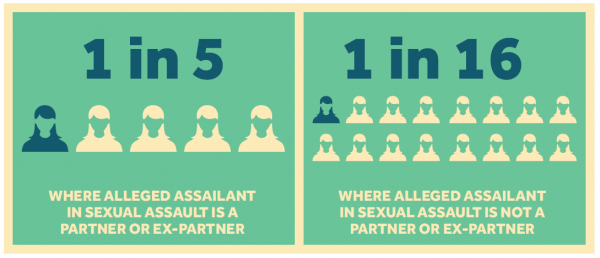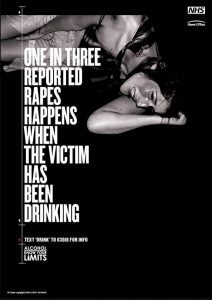Sexual violence can have devastating consequences for victims. In this blog, Dr Catherine White, Dr Rabiya Majeed-Ariss and Professor David Gadd explore how gender intersects with social demographic characteristics to compound vulnerabilities and complicate access to services.
- Most adult victims of sexual violence are females, and perpetrators of sexual violence are predominantly male. In 2017, 20.3% of women and 3.8% of men aged 16-59 had experienced an actual or attempted sexual assault since the age of 16, equivalent to an estimated 3.4 million female victims and 631,000 male victims.
- Only very few police investigations on reported sexual assault cases conclude with a conviction. Policymakers must not pretend that improvements in prosecution and convictions rates are imminent, even though they are necessary.
- Gender and intersecting vulnerabilities such as age, ethnicity, mental health, learning difficulties and adverse childhood experiences, make it critical to routinely appraise how accessible services are to survivors.
- Whilst it is acknowledged that most men are appalled by sexual violence and do not rape, a public conversation about why most sexual violence perpetrators are men must be opened.
Sexual violence, including rape and sexual assault, can devastate victims: in the short term when, in addition to psychological trauma, some have also to contend with injuries, unwanted pregnancy and sexually transmitted infections; and in the longer term, when problems with infertility, sexual dysfunction, post-traumatic stress disorder, and anxiety and depression emerge. In the UK, less than one in six victims of sexual assault report to the police.
Most adult victims are female. Perpetrators are predominantly male. The Crime Survey for England and Wales (CSEW) estimated that in 2017:
- 20.3% of women and 3.8% of men aged 16-59 had experienced an actual or attempted sexual assault since the age of 16, equivalent to an estimated 3.4 million female victims and 631,000 male victims;
- 3.1% of women and 0.8 of men aged 16-59 had experienced an actual or attempted sexual assault in the previous year.
In focussing on numbers of people – rather than what has happened to them – such statistics understate gender disparities. Earlier sweeps of the British Crime Survey revealed that women who have been recently sexually assaulted suffered on average two incidents in the last year. Female victims are more likely than men to have been repeatedly victimised, often by the same perpetrator and most typically a current or former partner. Men who have been sexually assaulted more than once are more likely to have been abused by separate perpetrators over their lifetimes, with only a third of male rapes perpetrated by current or former partners. The accompanying violence perpetrated against some victims during sexual assaults can be life-threatening. For example, one in five of the adult women who attended Saint Mary’s Sexual Assault Referral Centre (SARC) in Manchester for a Forensic Medical Examination in 2017 following a sexual assault by a partner or ex-partner had also been strangled (see Figure 1).
Figure 1. Prevalence of non-fatal strangulation in Saint Mary’s SARC cases
Age and ethnicity
It needs to be understood how gender intersects with other social demographic characteristics to compound vulnerabilities and complicate access to services. The media has focussed on women aged 16-25, who are more than twice as likely as women aged 26-59 to have been sexually assaulted in the last year. Such attention has nevertheless encouraged stereotyping. Some government awareness campaigns, for example, have implied that young women who drink alcohol are to blame if they are sexually assaulted (see Figure 2).
Figure 2. NHS Drinking Awareness poster
Such stereotyping also impacts on access to service provision, discouraging victims who have consumed drugs or alcohol from seeking support and promoting the view that older women are rarely raped. Very few women aged 70 or over referred to Saint Mary’s for forensic medical examinations subsequently attended the counselling sessions available there. Indeed, research reveals that among all age groups, victims are much more likely to first disclose being sexually assaulted to a relative, friend or colleague than to the police or other professionals. Around a third of survivors have never told anyone and there are good reasons for thinking that people from minority ethnic groups are ill-served by service providers. The 2011 Census estimated the black, Asian and minority ethnic (BAME) population of Greater Manchester to be 17%, but in 2017 only 13% per cent of referrals to Saint Mary’s were from BAME groups. In 2018, Saint Mary’s saw only one person who described themselves as Jewish, and no one who identified as Chinese.
As the UK debate around ‘organised’ child sexual abuse has become unduly racialised, insufficient attention has been paid to the vulnerabilities of children. Analysis of data relating to all 986 examinations of children and young people living in Greater Manchester over a three-year period showed that:
- 86% of the children and young people attending Saint Mary’s following sexual assaults were girls and 14% were boys. Among those aged under 12, however, boys accounted for one-quarter of the total. On average, boys were younger than girls – the median age for boys was 6 years and for girls 13 years;
- children and young people from minority ethnic groups were under-represented in the client population;
- mental health difficulties were frequently reported by service users aged 12-17: 40% reported mental health issues; 35% reported self-harm; and 12% reported suicide attempts prior to their attendance at the SARC.
Mental health, learning difficulties and adverse childhood experiences
Whilst it is estimated that 15.7% of the adult population have a mental health disorder, 69% of adult clients attending Saint Mary’s for a forensic medical examination reported long-standing mental health problems predating the recent assault. Having a learning disability also appears to make people more vulnerable to sexual violence. Whilst 2% of the general UK population are reported to have a learning disability, 7.5% of clients at Saint Mary’s SARC have one. Adverse childhood experiences are often connected to both learning difficulties and mental health problems. Over one-quarter of the young people referred to Saint Mary’s SARC are regarded by social services as children in need of protection, suggesting that failures of safeguarding from an early age play a part in many survivors’ vulnerabilities.
The road ahead
The complexity of these intersecting vulnerabilities makes it critical to routinely appraise how accessible services are to survivors. It also, unfortunately, makes it imperative that service providers are honest with those in crisis about how infrequently police investigations deliver ‘justice’. As few as 4% of reported sexual assault cases result in a prosecution and less than three fifths of prosecutions conclude with a conviction. Policymakers must not pretend that improvements in prosecution and convictions rates are imminent, even if though they are necessary.
Instead, they must open a public conversation about why most perpetrators are men. This conversation needs to acknowledge that most men do not rape and that most men and boys are appalled by sexual violence. But it needs also to be clear about the degree to which myths about victim precipitation (the idea that how a victim interacts contributes to the crime being committed) enable some men and boys to define what counts as ‘rape’ more narrowly than the law. It must also highlight that a large minority of men remain reckless around issues of consent, oblivious to who can legitimately give it, and misguided about whether it can be assumed without asking.
This article was originally published in On Gender, a collection of essays providing analysis and ideas on taking a gendered lens to policy in Greater Manchester and devolved regions across the UK. You can read the full publication here.
Policy@Manchester aims to impact lives globally, nationally and locally through influencing and challenging policymakers with robust research-informed evidence and ideas. Visit our website to find out more, and sign up to our newsletter to keep up to date with our latest news.


